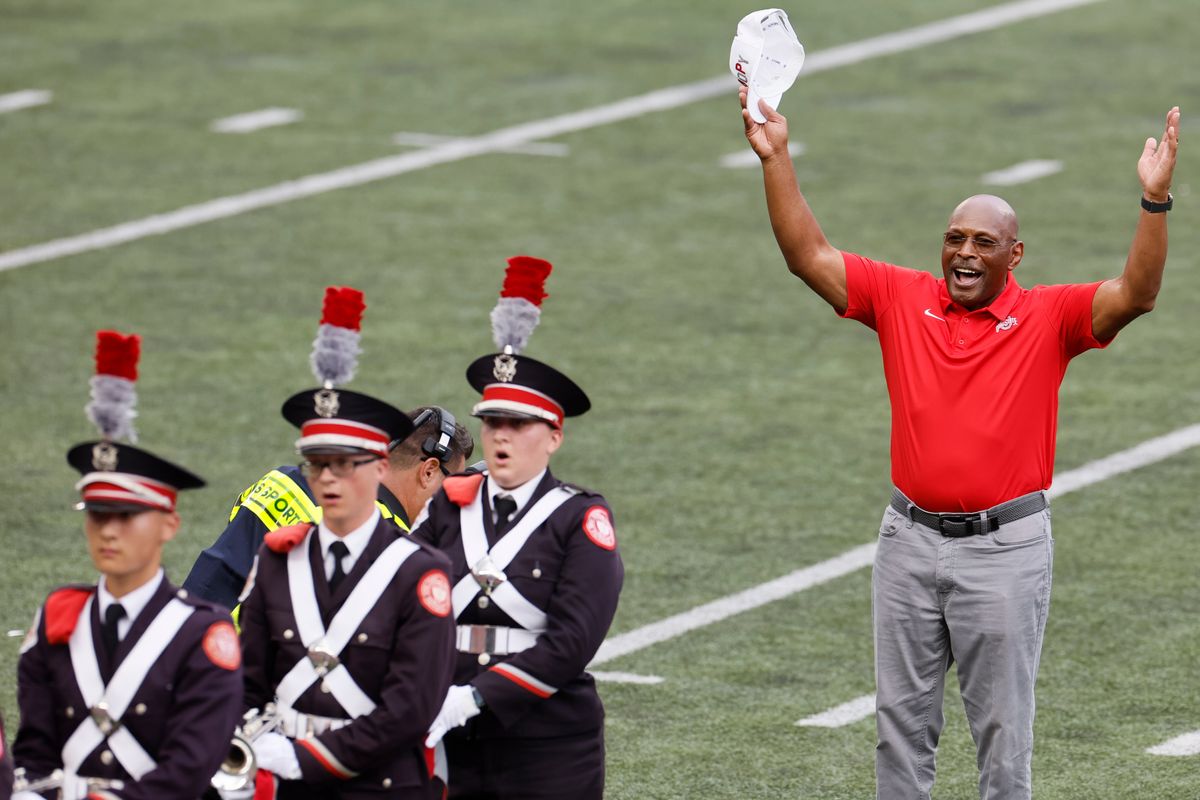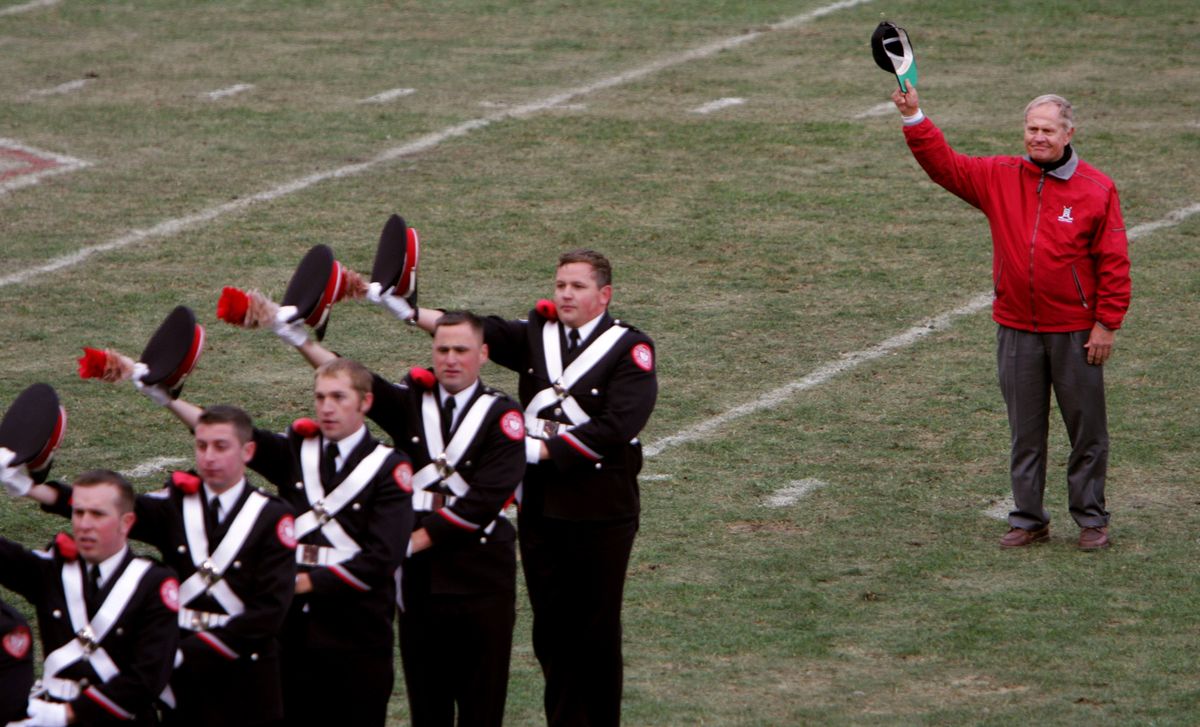COLUMBUS, Ohio (AP) — Lots of kids who grow up in Ohio dream of scoring a touchdown in front of 100,000 Buckeyes fans at Ohio Stadium.
While many dream of celebrating in the end zone, a smaller group of Sousaphone players aspire to dot the i and complete “Script Ohio” before the Buckeyes take the field.
At 89 years old, Script Ohio not only remains one of the greatest traditions in college football, but also serves as a signature for Ohio State University and the entire state.
“It is something that I’ve been dreaming of for years,” said Joseph Orr of Chillicothe, Ohio, who will be the i dotter when the top-ranked Buckeyes host UCLA on Saturday night. “For me to be able to do that and represent my family in South Central Ohio means a great deal to me.”
The tradition is intertwined with the band’s legacy. This is the 148th edition of The Ohio State University Marching Band — nicknamed “The Best Damn Band in the Land.” However, Script Ohio itself began on Oct. 24, 1936, against archrival Michigan.
Band Director Eugene J. Weigel designed the script formation after seeing the marquee sign above the Loew’s Ohio Theatre in Columbus.
“I think Script Ohio is one of the most important things that we do. It’s one of the most important things in college marching band history, and so we obviously take it very seriously and we know our fans appreciate it,” current band director Dr. Christopher Hoch said. “We are aware that fans across the country know about it and expect it whenever we take the field, even not in our own home stadium.”
Who gets to dot the i?
The honor of dotting the i is for fourth- and fifth-year sousaphone players. There are eight this year. Each will have one chance to do it at Ohio Stadium this season, either before the game or at halftime.
Earning the opportunity to dot the i starts the moment a sousaphone player makes the band. Out of 28, only 24 march during games, increasing the competition.
The order in which a sousaphone player chooses which game they will dot the i is determined by rank. Most points are awarded for the number of performances a player has completed during their OSU career. Players with higher point totals have priority in selecting their game. Like football players competing in practice, band members also challenge one another to be ready for game day.
“There are so many people who have supported me and lifted me up when I’m down,” Orr said. “I did not make the band on the first try, but I think that was an important part of my development to keep working hard and digging deep and finding out what it really means to me. Now this is just kind of the cherry on top.”
Each i-dotter brings a unique story, like Sydney Reeves, who dotted the i at halftime during the Grambling and Minnesota games. She follows in the footsteps of her parents, Wendy and Chad Reeves, both former sousaphone players and i-dotters.
Interestingly, a sousaphone player didn’t start dotting the i until 1937. John Brungart, an E-flat cornet player, was the first to do so.
On rare occasions, senior sousaphone players invite a non-band member to dot the i. Two-time Heisman Trophy winner Archie Griffin was the most recent honorary i-dotter during the 2024 opener against Akron. Others have included Bob Hope (1978), Jack Nicklaus (2006), Sen. John and Annie Glenn (2009), 100-year-old alumnus Anthony Violi (2018), and former coaches Woody Hayes (1983) and Earl Bruce (2016).
Taking center stage
Script Ohio is performed while the band plays Robert Planquette’s “Le Régiment de Sambre et Meuse.” The formation begins with three blocks and unfolds into a long, singular line, all led by the drum major.
Near the end, as the band begins the final letter, the drum major joins the i dotter. They often high-five. The drum major starts hyping up the i-dotter. With 16 measures left in “Le Régiment,” the two strut to the top of the i. The drum major points to the spot. The i-dotter turns and bows to both sides of the crowd.
“This is a huge moment for them. They get to dot the i in front of 100,000 people, the greatest tradition in college football. It’s encouraging them to embrace the moment,” assistant drum major Brian Speckman said.
For the dotter, the i is broken into two parts — the strut to the i and the bow. Orr said he has practiced the strut a lot over the past year.
“It’s kind of like a hitch kick motion where you’re driving your knee up and then flicking out your foot and trying to keep your toe pointed,” he said. “It’s difficult to get good leg height with a sousaphone on your back, leaning back. It’s kind of disorienting. But that’s something that we specialize in here, just having very athletic, very trained people who want to make things look the absolute best that they can.
“I’ve received a lot of advice about technique. If you can find someone who marches a lot like you, they can be of great assistance.”
Tradition also doesn’t take a backseat to anyone. An ESPN cameraman learned that during a 2009 game against Southern California, he got too close to Frank Cosenza. As Cosenza did his bow, the bell of the 40-pound sousaphone took out the camera.
With the College Football Playoff expanding last year, there are now at least two additional opportunities to dot the i. These are decided in a “dot off,” where sousaphone players perform their strut and showcase their abilities.
“Script Ohio is one of those everlasting parts of Ohio State tradition. I think that says something about the people of Ohio: we like tradition, we like honor, and it means a lot that we always prioritize being the best we can be, whether it’s our football program or our band program. Some things just aren’t meant to change, and I think we find great comfort in that.”
___
Get poll alerts and updates on the AP Top 25 throughout the season. Sign up here and here (AP News mobile app). AP college football: https://apnews.com/hub/ap-top-25-college-football-poll and https://apnews.com/hub/college-football
By JOE REEDY
AP Sports Writer



